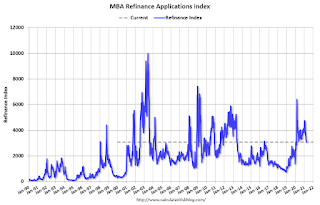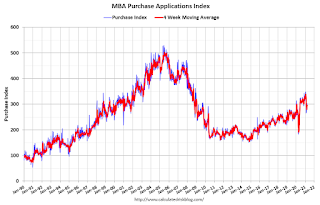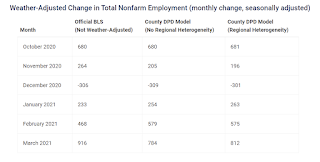by Calculated Risk on 4/07/2021 09:00:00 PM
Wednesday, April 07, 2021
Thursday: Unemployment Claims, Fed Chair Powell
Thursday:
• At 8:30 AM ET, The initial weekly unemployment claims report will be released. The consensus is for a decrease to 700 thousand from 719 thousand last week.
• AT 12:00 PM, Discussion, Fed Chair Jerome Powell, The Global Economy, At the International Monetary Fund Debate on the Global Economy (Watch live)
April 7th COVID-19 Vaccinations, New Cases, Hospitalizations
by Calculated Risk on 4/07/2021 04:50:00 PM
Note: I'm looking forward to not posting this daily! I've been posting this data daily for over a year, and I'll stop once all three of these criteria are met:
1) 70% of the population over 18 has had at least one dose of vaccine,
2) new cases are under 5,000 per day, and
3) hospitalizations are below 3,000.
According to the CDC, 171.5 million doses have been administered. 24.9% of the population over 18 is fully vaccinated, and 42.4% of the population over 18 has had at least one dose (109.4 million people have had at least one dose).
And check out COVID Act Now to see how each state is doing.
 Click on graph for larger image.
Click on graph for larger image.This graph shows the daily (columns) 7 day average (line) of positive tests reported.
Note: The ups and downs during the Winter surge were related to reporting delays due to the Thanksgiving and Christmas holidays.
This data is from the CDC.
The second graph shows the number of people hospitalized.
 This data is also from the CDC.
This data is also from the CDC.The CDC cautions that due to reporting delays, the area in grey will probably increase.
FOMC Minutes: "The path of the federal funds rate and the balance sheet depend on actual progress"
by Calculated Risk on 4/07/2021 03:39:00 PM
From the Fed: Minutes of the Federal Open Market Committee, March 16-17, 2021. A few excerpts:
In their discussion of current conditions, participants noted that the COVID-19 pandemic was causing tremendous human and economic hardship across the United States and around the world. Following a moderation in the pace of the recovery, indicators of economic activity and employment had turned up recently, although the sectors most adversely affected by the pandemic remained weak. Inflation continued to run below 2 percent. Overall financial conditions remained accommodative, in part reflecting policy measures to support the economy and the flow of credit to U.S. households and businesses. Participants noted that the path of the economy would depend significantly on the course of the virus, including progress on vaccinations, and that the ongoing public health crisis would continue to weigh on economic activity, employment, and inflation and posed considerable risks to the economic outlook.
...
Participants judged that the Committee's current guidance for the federal funds rate and asset purchases was serving the economy well. They noted that a benefit of the outcome-based guidance was that it did not need to be recalibrated often in response to incoming data or the evolving outlook. Participants also noted the importance of communicating to the public that the existing guidance, together with the new monetary policy framework as delineated in the revised Statement on Longer-Run Goals and Monetary Policy Strategy, meant that the path of the federal funds rate and the balance sheet depend on actual progress toward reaching the Committee's maximum-employment and inflation goals. In particular, various participants noted that changes in the path of policy should be based primarily on observed outcomes rather than forecasts.
Participants agreed that overall financial conditions were accommodative. They noted that the Federal Reserve's asset purchases since last March had materially eased financial conditions and were providing substantial support to the economy. Participants noted that it would likely be some time until substantial further progress toward the Committee's maximum-employment and price-stability goals would be realized and that, consistent with the Committee's outcome-based guidance, asset purchases would continue at least at the current pace until then. A number of participants highlighted the importance of the Committee clearly communicating its assessment of progress toward its longer-run goals well in advance of the time when it could be judged substantial enough to warrant a change in the pace of asset purchases. The timing of such communications would depend on the evolution of the economy and the pace of progress toward the Committee's goals.
emphasis added
Northwest Real Estate in March: Sales up 16% YoY, Inventory down 56% YoY
by Calculated Risk on 4/07/2021 01:39:00 PM
Note: Inventory is down sharply in the Northwest almost everywhere except Seattle. And inventory is low in Seattle too, but was even lower a year ago.
The Northwest Multiple Listing Service reported Northwest MLS brokers say bidding wars, escalating prices, and buyer fatigue are widespread
“There’s no April fooling when it comes to how hot the housing market is right now,” commented J. Lennox Scott, chairman and CEO of John L Scott Real Estate. “In King, Snohomish, Pierce and Kitsap counties, the current spring market we’re seeing is one of the best on record.”The press release is for the Northwest MLS area. There were 7,803 closed sales in March 2021, up 15.9% from 6,735 sales in March 2020. Active inventory for the Northwest is down 55.9%.
James Young, director of the Washington Center for Real Estate Research at the University of Washington, agreed, noting March marked the first post-COVID/pre-COVID comparison. “It is very difficult to compare year-on-year results once lockdown started in late March 2020,” he stated.
“The drop in the number of active listings between now and last year is extraordinary,” Young exclaimed. NWMLS statistics show a 55.9% decline in total active listings, shrinking from 9,418 at the end of March 2020 to 4,153 at month end. Young noted the decrease is even more pronounced in “peripheral counties.” Six counties (Clallam, Clark, Island, Kittitas, Mason, and San Juan) experienced year-over-year declines of 69% or higher, according to the latest report from Northwest MLS.
emphasis added
In King County, sales were up 20.7% year-over-year, and active inventory was down 37.1% year-over-year.
In Seattle, sales were up 33.5% year-over-year, and inventory was UP 7.3% year-over-year. (inventory in Seattle was extremely low last year). This puts the months-of-supply in Seattle at just 0.95 months.
Some thoughts on increasing the Homeowner Housing Supply in the Short Term
by Calculated Risk on 4/07/2021 11:09:00 AM
Currently "For Sale" housing inventories are at record low levels. What could lead to more supply in the short term?
First, as the pandemic subsides, potential sellers will be more willing to list their homes (and allow strangers into their homes). So I expect more inventory later this year (See Some thoughts on Housing Inventory)
Second, an increase in mortgage rates (if this continues) would likely slow demand (usually demand picks up when interest rates first start to increase, as buyers are afraid of missing out on low rates). But if 30 year fixed rate mortgages move up closer to 4% (from the current 3.34%), this will probably slow demand.
 Click on graph for larger image.
Click on graph for larger image.Trade Deficit Increased to $71.1 Billion in February
by Calculated Risk on 4/07/2021 08:44:00 AM
From the Department of Commerce reported:
The U.S. Census Bureau and the U.S. Bureau of Economic Analysis announced today that the goods and services deficit was $71.1 billion in February, up $3.3 billion from $67.8 billion in January, revised.
February exports were $187.3 billion, $5.0 billion less than January exports. February imports were $258.3 billion, $1.7 billion less than January imports.
emphasis added
 Click on graph for larger image.
Click on graph for larger image.Both exports and imports decreased in February.
Exports are down 10.0% compared to February 2020; imports are up 5.0% compared to February 2020.
Both imports and exports decreased sharply due to COVID-19, and have now bounced back (imports much more than exports),
The second graph shows the U.S. trade deficit, with and without petroleum.
 The blue line is the total deficit, and the black line is the petroleum deficit, and the red line is the trade deficit ex-petroleum products.
The blue line is the total deficit, and the black line is the petroleum deficit, and the red line is the trade deficit ex-petroleum products.Note that net, imports and exports of petroleum products are close to zero.
The trade deficit with China increased to $24.6 billion in February, from $16.0 billion in February 2020.
MBA: Mortgage Applications Decrease in Latest Weekly Survey
by Calculated Risk on 4/07/2021 07:00:00 AM
From the MBA: Mortgage Applications Decrease in Latest MBA Weekly Survey
Mortgage applications decreased 5.1 percent from one week earlier, according to data from the Mortgage Bankers Association’s (MBA) Weekly Mortgage Applications Survey for the week ending April 2, 2021.
... The Refinance Index decreased 5 percent from the previous week and was 20 percent lower than the same week one year ago. The seasonally adjusted Purchase Index decreased 5 percent from one week earlier. The unadjusted Purchase Index decreased 4 percent compared with the previous week and was 51 percent higher than the same week one year ago.
“Mortgage rates resumed their upward move last week, with the 30-year fixed rate at 3.36 percent. The return of rates to the highest level since last June contributed to a slowdown in applications for both purchases and refinances. The rapidly recovering economy and improving job market is generating sizeable home buying demand, but activity in recent weeks is constrained by quicker home-price growth and extremely low inventory,” said Joel Kan, MBA’s Associate Vice President of Economic and Industry Forecasting. “Refinance applications declined for the fifth straight week, but there was a gain in VA loan activity. Overall, refinance demand has decreased, with volume over the past 10 weeks down by more than 30 percent.”
...
The average contract interest rate for 30-year fixed-rate mortgages with conforming loan balances ($548,250 or less) increased to 3.36 percent from 3.33 percent, with points increasing to 0.43 from 0.39 (including the origination fee) for 80 percent loan-to-value ratio (LTV) loans.
emphasis added
 Click on graph for larger image.
Click on graph for larger image.The first graph shows the refinance index since 1990.
With low rates, the index remains elevated, but falling as rates rise.
The second graph shows the MBA mortgage purchase index
 According to the MBA, purchase activity is up 51% year-over-year unadjusted.
According to the MBA, purchase activity is up 51% year-over-year unadjusted.Note: Until the 2nd half of May, the MBA index will be up sharply year-over-year since purchase activity collapsed in late March 2020 in the early weeks of the pandemic.
Note: Red is a four-week average (blue is weekly).
Tuesday, April 06, 2021
Wednesday: Trade Deficit, FOMC Minutes
by Calculated Risk on 4/06/2021 09:00:00 PM
Wednesday:
• At 7:00 AM ET, The Mortgage Bankers Association (MBA) will release the results for the mortgage purchase applications index.
• At 8:30 AM, Trade Balance report for February from the Census Bureau. The consensus is the trade deficit to be $70.3 billion. The U.S. trade deficit was at $68.2 billion in January.
• At 2:00 PM, FOMC Minutes, Minutes Meeting of March 16-17, 2021
SF Fed: Weather Increased March Employment by About 100 Thousand
by Calculated Risk on 4/06/2021 05:04:00 PM
Every month, the San Francisco Fed estimates Weather-Adjusted Change in Total Nonfarm Employment (monthly change, seasonally adjusted). They use local area weather to estimate the impact on employment.
The BLS reported 916 thousand jobs were added in March.
The San Francisco Fed estimates that weather adjusted employment gains were 812 thousand; about 100 thousand lower than the BLS reported.
This reverses the impact of weather on the February report, and was expected. This was especially evident in construction were there were 56 thousand construction jobs lost in February, and 110 thousand construction jobs added in March.
 Click on table for larger image.
Click on table for larger image.This table from Daniel Wilson at the SF Fed shows the BLS reported job gains for the last 6 months, and two estimates of the impact of weather.
April 6th COVID-19 Vaccinations, New Cases, Hospitalizations
by Calculated Risk on 4/06/2021 04:19:00 PM
Note: I've been posting this data daily for over a year. I'll stop once all three of these criteria are met:
1) 70% of the population over 18 has had at least one dose of vaccine,
2) new cases are under 5,000 per day, and
3) hospitalizations are below 3,000.
According to the CDC, 168.6 million doses have been administered. 24.4% of the population over 18 is fully vaccinated, and 41.7% of the population over 18 has had at least one dose (107.6 million people have had at least one dose).
And check out COVID Act Now to see how each state is doing.
 Click on graph for larger image.
Click on graph for larger image.This graph shows the daily (columns) 7 day average (line) of positive tests reported.
Note: The ups and downs during the Winter surge were related to reporting delays due to the Thanksgiving and Christmas holidays.
This data is from the CDC.
The second graph shows the number of people hospitalized.
 This data is also from the CDC.
This data is also from the CDC.The CDC cautions that due to reporting delays, the area in grey will probably increase.


